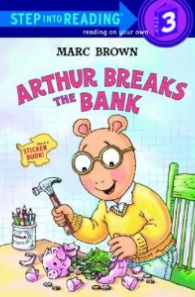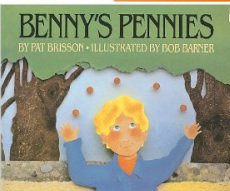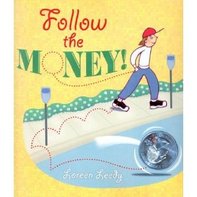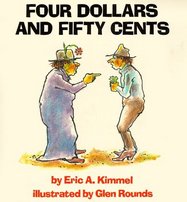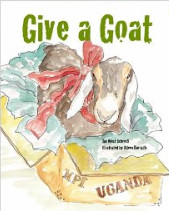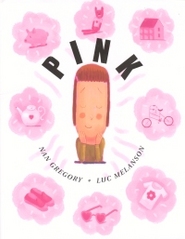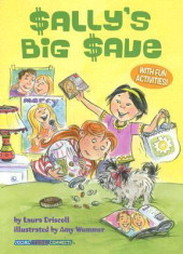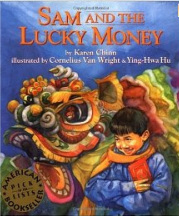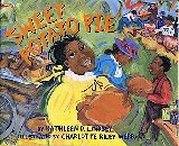Children's Literature- Fiction A-Z
Click on any picture of a book to open a new external window with the Amazon.com listing of that book.
Title: Arthur Breaks the Bank
Author: Marc Brown
Illustrator: Marc Brown
ISBN#: 0375810021
Theme: Money; Saving; Giving
Recommended for Grade Level: K-2
Assessment Rating: 5-Excellent
Assessment:
This is a leveled reader: Step 3 in “Step into Reading: Reading on your Own.” In this book, Arthur learns how satisfying it can be to save money instead of spending it, and to do something special for someone he loves. Key vocabulary is highlighted in blue, so that beginning readers can participate in shared reading. This would be an ideal book for small group instruction, and is developmentally appropriate for teaching concepts of saving and economic choice.
Author: Marc Brown
Illustrator: Marc Brown
ISBN#: 0375810021
Theme: Money; Saving; Giving
Recommended for Grade Level: K-2
Assessment Rating: 5-Excellent
Assessment:
This is a leveled reader: Step 3 in “Step into Reading: Reading on your Own.” In this book, Arthur learns how satisfying it can be to save money instead of spending it, and to do something special for someone he loves. Key vocabulary is highlighted in blue, so that beginning readers can participate in shared reading. This would be an ideal book for small group instruction, and is developmentally appropriate for teaching concepts of saving and economic choice.
Title: Benny’s Pennies
Author: Pat Brisson
Illustrator: Bob Barner
ISBN#: 0153134127
Theme: Economic Choice; Spending; Counting (backwards and forwards)
Recommended for Grade Level: K-2
Assessment Rating: 5-Excellent
Assessment:
This book is beautifully illustrated with colorful collages, and includes predictable text and opportunities for practicing counting, both forwards and backwards. This is an ideal read-aloud text for primary grades, and would be great for retelling and acting out because of the predictability and repetition in the text.
Author: Pat Brisson
Illustrator: Bob Barner
ISBN#: 0153134127
Theme: Economic Choice; Spending; Counting (backwards and forwards)
Recommended for Grade Level: K-2
Assessment Rating: 5-Excellent
Assessment:
This book is beautifully illustrated with colorful collages, and includes predictable text and opportunities for practicing counting, both forwards and backwards. This is an ideal read-aloud text for primary grades, and would be great for retelling and acting out because of the predictability and repetition in the text.
Title: The Berenstain Bears Get the Gimmies
Author: Stan & Jan Berenstain
Publication: 1988, Random House, Inc.
ISBN #: 0-394-80566-0
Theme: Needs versus wants
Recommended for Grade Levels: K through 2
Assessment Ranking: 3-Fair
Assessment:
This book is about Brother and Sister’s problems with the “galloping gimmies” – that is they are acting in a selfish and inappropriate manner. It covers the concepts of self-control and greediness is an excellent manner. It could be used as a read aloud for kindergarten and into early first grade. It could also be used as book for independent reading for first to early second grade readers. I would use this book within the context of an introduction of wants versus needs. Strengths of the book include its use of language (vocabulary ranges from supermarket to embarrassing to disgraceful), the vivid and appropriate illustrations, and its total lack of bias (except for a decided negative view of greedy bears). The book is available in printed and electronic forms but no audio versions are available. The book also does not sufficiently cover the notions of a want versus a need as it focuses mostly on behavior. Overall, I believe that this is a delightful text that is useful for applying some behavior guidance into a unit on economics.
Title: Follow the Money!
Author/Illustrator: Loreen Leedy
Publication: 2002, Holiday House Publishers
ISBN #: 0823417948
Recommended for Grade Levels: K through 3
Theme: Money Knowledge
Assessment Ranking: 4-Good
Assessment:
Humor is the name of the game with this book. It presents how coins are made through coins talking to one another. It then presents how money is used to purchase items and tracks the money through the system. It makes a point of showing the names of all the presidents on each coin and/or paper bill. Money gets caught in vending machines, used at the grocery store, and given for allowance. The book also discusses a variety of concepts including: donating to charity, getting discounts off of retail price, collecting a pay check, and paying back loans. The graphics used in this book are excellent and will certainly keep the children’s interest. This book would be best used as a read aloud by the teacher in the lower grades or an independent reading book for Grade 3.
Humor is the name of the game with this book. It presents how coins are made through coins talking to one another. It then presents how money is used to purchase items and tracks the money through the system. It makes a point of showing the names of all the presidents on each coin and/or paper bill. Money gets caught in vending machines, used at the grocery store, and given for allowance. The book also discusses a variety of concepts including: donating to charity, getting discounts off of retail price, collecting a pay check, and paying back loans. The graphics used in this book are excellent and will certainly keep the children’s interest. This book would be best used as a read aloud by the teacher in the lower grades or an independent reading book for Grade 3.
Title: Four Dollars and Fifty Cents
Author: Eric A. Kimmel
Illustrator: Glen Rounds
Publication: 1989, Holiday House, Inc.
ISBN #: 0-8234-0817-5
Theme: Debt
Recommended for Grade Levels: 1 through 3
Assessment Ranking: 3-Fair
Assessment:
Shorty Long is a cowhand who owes everyone in town money and refuses to pay off his debts because he “hates to pay for anything that he thinks he can get for free.” However, the baker, Widow Macrea, decided it was time for Shorty to settle his debts. The story proceeds from there with a number of amusing twists and turns. An underlying theme to the book is the concept of consequences and owning up to your decisions (good or bad).
It could be used as a read aloud, for shared reading, or for independent reading for grades 1 through 3 as appropriate. It could also be used in a lesson where students took on the various characters and role-played what would happen next in the story (using their predictive skills). Strengths of the book include its use of language, the comical illustrations, and lack of bias. The book is available in printed form only. The book also does not sufficiently cover the concept of debt completely. For example, it doesn’t address why Shorty got into debt in the first place. Overall, I believe that this is an entertaining story that could be useful as an add-on to a lesson on debt but should not be used as the only literary text.
Shorty Long is a cowhand who owes everyone in town money and refuses to pay off his debts because he “hates to pay for anything that he thinks he can get for free.” However, the baker, Widow Macrea, decided it was time for Shorty to settle his debts. The story proceeds from there with a number of amusing twists and turns. An underlying theme to the book is the concept of consequences and owning up to your decisions (good or bad).
It could be used as a read aloud, for shared reading, or for independent reading for grades 1 through 3 as appropriate. It could also be used in a lesson where students took on the various characters and role-played what would happen next in the story (using their predictive skills). Strengths of the book include its use of language, the comical illustrations, and lack of bias. The book is available in printed form only. The book also does not sufficiently cover the concept of debt completely. For example, it doesn’t address why Shorty got into debt in the first place. Overall, I believe that this is an entertaining story that could be useful as an add-on to a lesson on debt but should not be used as the only literary text.
Title: Give a Goat
Author: Jan West Schrock
Illustrator: Aileen Darragh
ISBN#: 0884483010
Theme: Charity, money-making projects, Service learning
Recommended for Grade Level: 2-5
Assessment Rating: 5-Excellent
Assessment:
This book is about a class project in which a 5th grade class reads Beatrice’s Goat, about a girl in Uganda who cannot go to school until her family is given the gift of a goat through the organization Heifer, International. With the milk from the goat, the girl’s family has enough for themselves and enough to sell, so that Beatrice could go to school. The 5th graders in Give a Goat are inspired to raise money to buy a goat for a family, and over the course of their project, they learn about math, marketing, and the people of Uganda, as well as how good it feels to give a gift that makes a difference. This book, along with Beatrice’s Goat, could be the foundation for an integrated unit on giving, covering math and social studies, economics and international development. There would be opportunities to incorporate language arts and science with both cultural and agricultural aspects of a project like this.
Author: Jan West Schrock
Illustrator: Aileen Darragh
ISBN#: 0884483010
Theme: Charity, money-making projects, Service learning
Recommended for Grade Level: 2-5
Assessment Rating: 5-Excellent
Assessment:
This book is about a class project in which a 5th grade class reads Beatrice’s Goat, about a girl in Uganda who cannot go to school until her family is given the gift of a goat through the organization Heifer, International. With the milk from the goat, the girl’s family has enough for themselves and enough to sell, so that Beatrice could go to school. The 5th graders in Give a Goat are inspired to raise money to buy a goat for a family, and over the course of their project, they learn about math, marketing, and the people of Uganda, as well as how good it feels to give a gift that makes a difference. This book, along with Beatrice’s Goat, could be the foundation for an integrated unit on giving, covering math and social studies, economics and international development. There would be opportunities to incorporate language arts and science with both cultural and agricultural aspects of a project like this.
Title: Money, Money, Honey Bunny!
Author: Marilyn Sadler
Illustrator: Roger Bollen
ISBN#: 0375833706
Theme: Saving, Giving, Money
Recommended for Grade Level: K-2
Assessment Rating:3-Fair
Assessment:
This colorful and fun book contains math, social studies, and language arts content that will be enjoyable for students. Honey Bunny saves her money and is then able to buy things for all of her friends, as well as a little for herself, even as she continues to save. The rhyming word play is delightful, with great opportunities for vocabulary development. The rating of 4 is primarily because this book is a better vehicle for teaching sharing and language arts than it is for teaching economics concepts. The major drawback of this book is that it does not force Honey Bunny to make economic choices. She has enough money that she can save it, and at the same time, buy everything she wants.
Author: Marilyn Sadler
Illustrator: Roger Bollen
ISBN#: 0375833706
Theme: Saving, Giving, Money
Recommended for Grade Level: K-2
Assessment Rating:3-Fair
Assessment:
This colorful and fun book contains math, social studies, and language arts content that will be enjoyable for students. Honey Bunny saves her money and is then able to buy things for all of her friends, as well as a little for herself, even as she continues to save. The rhyming word play is delightful, with great opportunities for vocabulary development. The rating of 4 is primarily because this book is a better vehicle for teaching sharing and language arts than it is for teaching economics concepts. The major drawback of this book is that it does not force Honey Bunny to make economic choices. She has enough money that she can save it, and at the same time, buy everything she wants.
Title: Pink
Author: Nan Gregory
Illustrator: Luc Melanson
Publication: 2007, Groundwood Books/House of Anansi Press
ISBN #: 978-0-88899-781-4
Theme: Need versus want; Saving
Recommended for Grade Levels: K through 3
Assessment Ranking: 5-Excellent
Assessment:
This book is about a young girl named Vivi who wants pink things just like the more affluent girls at school. It explains the discrepancies in socioeconomic levels between Vivi and her classmates in a realistic and heartwarming way. Vivi works to save what she can get her ultimate goal, a pink bride doll. The interesting twist to this book is that Vivi does not get the doll at the end and she learns that she will survive without it. I really like how the book is so based in the real-world and that in the end, Vivi is appreciative of what she has versus what she doesn’t. I particularly like the figurative language used within the book (e.g., “It’s hard to go fast when your heart is a stone.”) The illustrations were lovely with what seemed and endless variety of pink. From a bias perspective, you did get the message that the more affluent students at Vivi’s school where petty and mean-spirited, however I believe that can be overlooked in favor of the reality check this text provides. The concepts of want versus need and saving up for something special are handled particularly well. I would recommend this book as a read-aloud for kindergarten through grade 3 followed by a discussion of (a) wants versus needs; (b) saving up for something you want; and (c) appreciating what you have in your life, family, etc. The book is available in printed forms only.
This book is about a young girl named Vivi who wants pink things just like the more affluent girls at school. It explains the discrepancies in socioeconomic levels between Vivi and her classmates in a realistic and heartwarming way. Vivi works to save what she can get her ultimate goal, a pink bride doll. The interesting twist to this book is that Vivi does not get the doll at the end and she learns that she will survive without it. I really like how the book is so based in the real-world and that in the end, Vivi is appreciative of what she has versus what she doesn’t. I particularly like the figurative language used within the book (e.g., “It’s hard to go fast when your heart is a stone.”) The illustrations were lovely with what seemed and endless variety of pink. From a bias perspective, you did get the message that the more affluent students at Vivi’s school where petty and mean-spirited, however I believe that can be overlooked in favor of the reality check this text provides. The concepts of want versus need and saving up for something special are handled particularly well. I would recommend this book as a read-aloud for kindergarten through grade 3 followed by a discussion of (a) wants versus needs; (b) saving up for something you want; and (c) appreciating what you have in your life, family, etc. The book is available in printed forms only.
Title: Sally’s Big Save
Author: Laura Driscoll
Illustrator: Amy Wummer
Publication: 2006, Kane Press, Inc.
ISBN #: 1-57565-164-5
Theme: Saving
Recommended for Grade Levels: 2 through 3
Assessment Ranking: 5-Excellent
Assessment:
This book is about a girl named Sally who is a big fan of a rock star by the name of Marcy Mayne. Sally wants to go to Marcy’s upcoming concert but the tickets are $75 each and Sally’s parents have told her that she needs to save her allowance in order to purchase the tickets. The book goes on to explain a variety of methods that Sally has come up with for her family to save (e.g., sticking to a budget, clipping coupons, earning extra money at a yard sale). The book makes excellent connections to the economic concepts of saving, spending, budgeting, income, expenses, and interest. This fictional story is amusing and would interest students in the lower elementary grade levels. I would use it as a guided reading and/or independent reading book in grades 2 to 3. This book would be appropriate as an introduction to a lesson on saving so that the students understand that one reason to save is to have sufficient funds for something they want in the future. This is an important concept for students to learn. One of the features of the book that I particularly like is the way that definitions are provided for words such as budget, expense, and comparison shopping – they are shown in small inserts on the page but do not take away from the flow of the story. The book is available in printed form and is part of the Social Studies Connects™ series of children’s books. Overall, I believe that this is an excellent text to address the concept of saving within an economics unit.
Title: Sam and the Lucky Money
Author: Karen Chinn
Illustrator: Cornelius Van Wright & Ying-Hwa Hu
ISBN#: 9781880000533
Theme: Chinese New Year, Giving, wants & needs
Recommended for Grade Level: 2-5
Assessment Rating: 5-Excellent
Assessment:
This is a beautifully illustrated book that incorporates Chinese culture, holidays, and ties in well with wants and needs. In the story, Sam is given 4 lucky dollars as a gift for Chinese New Year. Although he is tempted by sweets and toys, and experiences momentary frustration that his money can’t buy him anything he wants, his ultimate choice is touching and thought-provoking. This would be an ideal read-aloud for grades 2-3, or an independent reading or buddy reading for grades 4-5. This book is also available in a Chinese edition and a Spanish edition.
Author: Karen Chinn
Illustrator: Cornelius Van Wright & Ying-Hwa Hu
ISBN#: 9781880000533
Theme: Chinese New Year, Giving, wants & needs
Recommended for Grade Level: 2-5
Assessment Rating: 5-Excellent
Assessment:
This is a beautifully illustrated book that incorporates Chinese culture, holidays, and ties in well with wants and needs. In the story, Sam is given 4 lucky dollars as a gift for Chinese New Year. Although he is tempted by sweets and toys, and experiences momentary frustration that his money can’t buy him anything he wants, his ultimate choice is touching and thought-provoking. This would be an ideal read-aloud for grades 2-3, or an independent reading or buddy reading for grades 4-5. This book is also available in a Chinese edition and a Spanish edition.
Title: Sweet Potato Pie
Author: Kathleen D. Lindsey
Illustrator: Charlotte Riley-Webb
Publication: 2003, Lee and Low Books, Inc.
ISBN #: 1-58430-061-2
Theme: Income
Recommended for Grade Levels: 1 through 4
Assessment Ranking: 4-Good
Assessment:
Kathleen Lindsey does a masterful job in this book of showing how a family can work together to achieve a goal. It is summertime and a drought has destroyed most of the crops except for the sweet potatoes. Sadie’s family must come up with $75 in one month or they will lose their farm. The family decides to sell Mama’s sweet potato pie at the upcoming fair to earn the needed money. The story covers the journey the family takes in trying to reach their goal and sell all their pies. The illustrations in this book are magnificent! The concept of income is implied and not overt but the reader still comes away with the understanding that hard work is required. I would use this book as a read-aloud or independent reading. Because the book contains a recipe for sweet potato pie (at the end of the book), an appropriate activity would be to have the students make pies for a bake sale of sorts – just as the characters in the story did. This would show the students that to earn income you must buy supplies, create a product or service, distribute your product/service, and ultimately sell your product/service. Such an activity would be economic concepts in action. Moreover, it could be used to address math subjects such as fractions and units of measurement. Strengths of the book include its use of language (the use of onomatopoeia, interesting dialogue, and alliteration), the colorful illustrations, its lack of bias, and its instructional flexibility. The book is available in printed and electronic forms but no audio versions are available. The book also does provide specific content area definitions (e.g., debt, income) rather focusing on the story of how the family worked together to meet its goals. This is a wonderful book that students will love, even though its relationship to economics is limited to that of earning money.
Kathleen Lindsey does a masterful job in this book of showing how a family can work together to achieve a goal. It is summertime and a drought has destroyed most of the crops except for the sweet potatoes. Sadie’s family must come up with $75 in one month or they will lose their farm. The family decides to sell Mama’s sweet potato pie at the upcoming fair to earn the needed money. The story covers the journey the family takes in trying to reach their goal and sell all their pies. The illustrations in this book are magnificent! The concept of income is implied and not overt but the reader still comes away with the understanding that hard work is required. I would use this book as a read-aloud or independent reading. Because the book contains a recipe for sweet potato pie (at the end of the book), an appropriate activity would be to have the students make pies for a bake sale of sorts – just as the characters in the story did. This would show the students that to earn income you must buy supplies, create a product or service, distribute your product/service, and ultimately sell your product/service. Such an activity would be economic concepts in action. Moreover, it could be used to address math subjects such as fractions and units of measurement. Strengths of the book include its use of language (the use of onomatopoeia, interesting dialogue, and alliteration), the colorful illustrations, its lack of bias, and its instructional flexibility. The book is available in printed and electronic forms but no audio versions are available. The book also does provide specific content area definitions (e.g., debt, income) rather focusing on the story of how the family worked together to meet its goals. This is a wonderful book that students will love, even though its relationship to economics is limited to that of earning money.
